IMPLEMENTATION | POTENTIAL | WORKSHOPS | TOOLS | READING LIST
A theatre educational project can work with documentary / biographical materials (videos, photos, texts, experiences…) with elements of improvisational theatre, movement, dance, music, theatrical-aesthetic tools and other artistic methods.
Under the choice of a topic or a theme, the educational project can be based on likewise, the choice of an existing play is possible. In the case of a play development, a working theme is needed, on the basis of which common scenes are developed, which result in a play or a collage. The working method is a democratic one, which takes place on an equal footing and has a participatory attitude.
Implementation in the project and Experiences
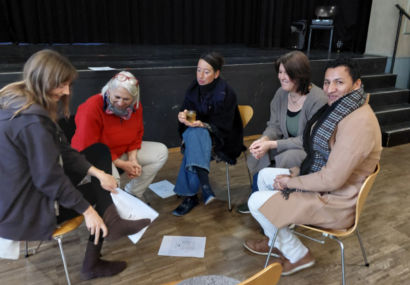 In the course of the play development the group rehearses under the theatre educational guidance and develops the common play in this process. During workshops, skills can be learned and developed, for example, through a dance workshop under professional instruction. In addition, workshops that include external persons can open up a productive space for feedback, criticism and suggestions.
In the course of the play development the group rehearses under the theatre educational guidance and develops the common play in this process. During workshops, skills can be learned and developed, for example, through a dance workshop under professional instruction. In addition, workshops that include external persons can open up a productive space for feedback, criticism and suggestions.
What to consider in the course of the theatre production?
before the project …
It needs a theatre educational guidance, a (direct) contact to the target group (this has to be defined beforehand). In the context of the acquisition of participants, the form of the participants must be considered. It needs a rehearsal plan and an adequate space in which to rehearse.
during the project …
It is important to discuss the goal of the project with the participants and to find a suitable way of working in which a positive group dynamic can develop. Therefore, at the beginning of the project, space should be given for group development. In addition, there needs to be sufficient time for experimentation, improvisation and discussion so that from this process proper scenes for the final product can develop. The framework is set by the theatre educational guidance, in which the group members have a creative freedom.
after the project …
After the play has been performed for the last time, it is a nice conclusion to have a final official meeting to review the process and get feedback. This can also be combined by watching the video documentation of the play together, if available.
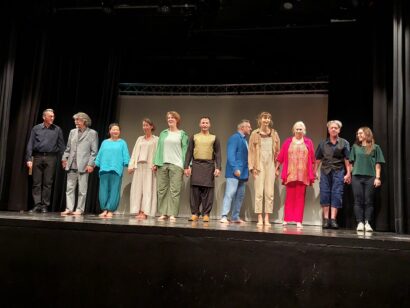
Potential of the method for transnational and multi-perspective approaches
Theatre is a medium that uses a variety of methods and can also combine the most diverse media. Moreover, theatre is very sensual and opens many possibilities of interpretation. Therefore, it is a suitable method to deal with transnational and multi-perspective approaches.
The greatest potential is to bring people’s stories, experiences and voices onto the stage. We are a transnational society, therefore these experiences also belong on stage and need to be seen, discussed and experienced. This enables visibility and opens up space for dialogue, exchange and can pave the way for change.
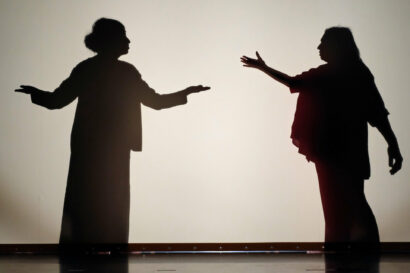 Another potential lies in the medium itself. It uses different possibilities of presentation, thereby creating reinforcement, impressiveness and arousing the most diverse emotions. One scene should be mentioned as an example from the collage. A wall was built from moving boxes in dynamic movements. The wall is so high that the actors and actresses disappear behind it. A picture emerges – a woman we interviewed. Her recording is projected onto the wall of cardboard boxes. The video is played. The actors and actresses, trying to create gaps in the wall, repeat words and phrases of the interviewee. Others quickly close the gaps again, thereby cutting off the words of the people behind the wall. Words and parts of sentences that were impressive and moving for the actors were amplified by them. As an audience member, you perceive the interviewee talking about her experiences and challenges of finding a foothold and being accepted in a new country, and you perceive the actors trying to tell the audience something, but always being prevented from doing so. If one creates a gap, it is immediately closed again. This is, among other things, a feeling that emerges from watching the interview and which was then theatrically brought onto the stage. Thus, these different levels of video, acting, text and perception are mutually dependent.
Another potential lies in the medium itself. It uses different possibilities of presentation, thereby creating reinforcement, impressiveness and arousing the most diverse emotions. One scene should be mentioned as an example from the collage. A wall was built from moving boxes in dynamic movements. The wall is so high that the actors and actresses disappear behind it. A picture emerges – a woman we interviewed. Her recording is projected onto the wall of cardboard boxes. The video is played. The actors and actresses, trying to create gaps in the wall, repeat words and phrases of the interviewee. Others quickly close the gaps again, thereby cutting off the words of the people behind the wall. Words and parts of sentences that were impressive and moving for the actors were amplified by them. As an audience member, you perceive the interviewee talking about her experiences and challenges of finding a foothold and being accepted in a new country, and you perceive the actors trying to tell the audience something, but always being prevented from doing so. If one creates a gap, it is immediately closed again. This is, among other things, a feeling that emerges from watching the interview and which was then theatrically brought onto the stage. Thus, these different levels of video, acting, text and perception are mutually dependent.
Workshops
An intensive warm-up is essential both for gathering concentration and for group development. An example of a workshop lesson is given here. In the rehearsal in question, we started with a game of association with the ball, then practiced dissociation: the group stands in a circle. Player A asks Player B: ‘What are you doing?’ Player A responds with a statement (e.g., ‘I’m cooking’), but at the same time performs a movement that shows something other than what she named. Player C asks player B: ‘What are you doing?’ Player B now performs as a movement what Player A said (but did not do), but at the same time says another activity, etc.
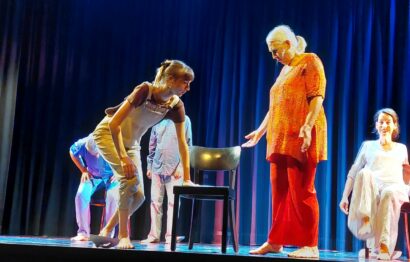
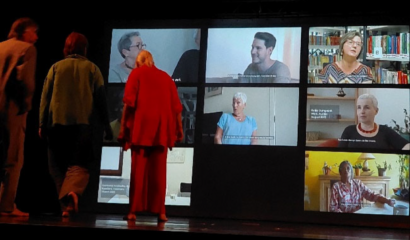
This was followed by a voice warm-up: The group stands in a circle and swings the upper body back and forth (toward the center of the circle) in a common rhythm (step tempo). Every participant then, taking turns, expresses a sound with her voice and the whole group repeats it.
In the main part of the rehearsal, we first watched a video together. Then, using a wall of moving boxes, we tried out different reactions of the group and individual participants to the video. The focus was on the question of whether still images or moving images are more effective. In this case, moving images proved to be more effective. Different players shifted the parts of the wall in such a way that gaps in the wall opened up again and again, through which faces became visible. The next step was to experiment with the interview text. Different players repeated individual words or parts of sentences from the interview to the movements of the group with the cardboard/wall elements. The final step was the attempt to capture the process in such a way that it could be repeated.
Experiences
 It turned out that it can take a long time to put together a reliable group. This led to the fact that for quite a while the level of knowledge about the project (e.g. knowledge of the interviews) and the level of familiarization within the group was quite heterogeneous. However, this changed and led to a working atmosphere characterized by a lot of playfulness and mutual trust. The group also mastered organizational shortages, room changes, etc. with an optimistic and constructive attitude.
It turned out that it can take a long time to put together a reliable group. This led to the fact that for quite a while the level of knowledge about the project (e.g. knowledge of the interviews) and the level of familiarization within the group was quite heterogeneous. However, this changed and led to a working atmosphere characterized by a lot of playfulness and mutual trust. The group also mastered organizational shortages, room changes, etc. with an optimistic and constructive attitude.
Impressions of the theatre premiere, Kulturzentrum Die GEMS, Singen, June 2023
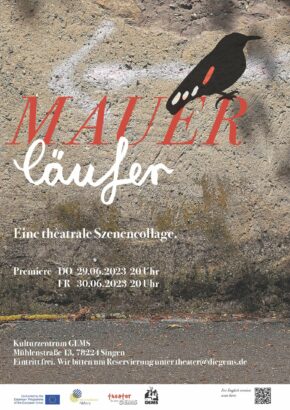
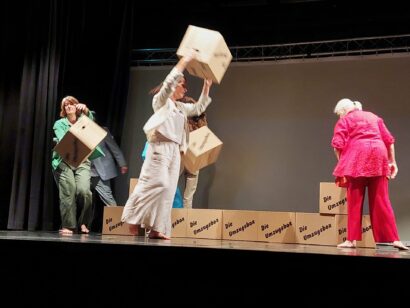
Reading list
Boal, A. (2013). Übungen und Spiele für Schauspieler und Nicht- Schauspieler. Berlin: Suhrkamp.
Hippe, L. (2019). Und was kommt jetzt? Szenisches Schreiben in der theaterpädagogischen Praxis. Weinheim: Deutscher Theaterverlag.
Johnstone, K. (2022). Improvisation und Theater. Die Kunst, spontan und kreativ zu agieren (6. Ausg.). Berlin: Alexander.
Pfeiffer, M. (2008). Theater des Handelns. Strategien der Performance- Art als Methode in der Theaterarbeit mit Jugendlichen. Weinheim: Deutscher Theaterverlag.
Plath, M. (2009). Biografisches Theater in der Schule. Mit Jugendlichen inszenieren: Darstellendes Spiel in der Sekundarstufe. Weinheim und Basel: Beltz.
Spolin, V. (2003). Improvisationstechniken für Pädagogik, Therapie und Theater. Paderborn: Junfermann.
